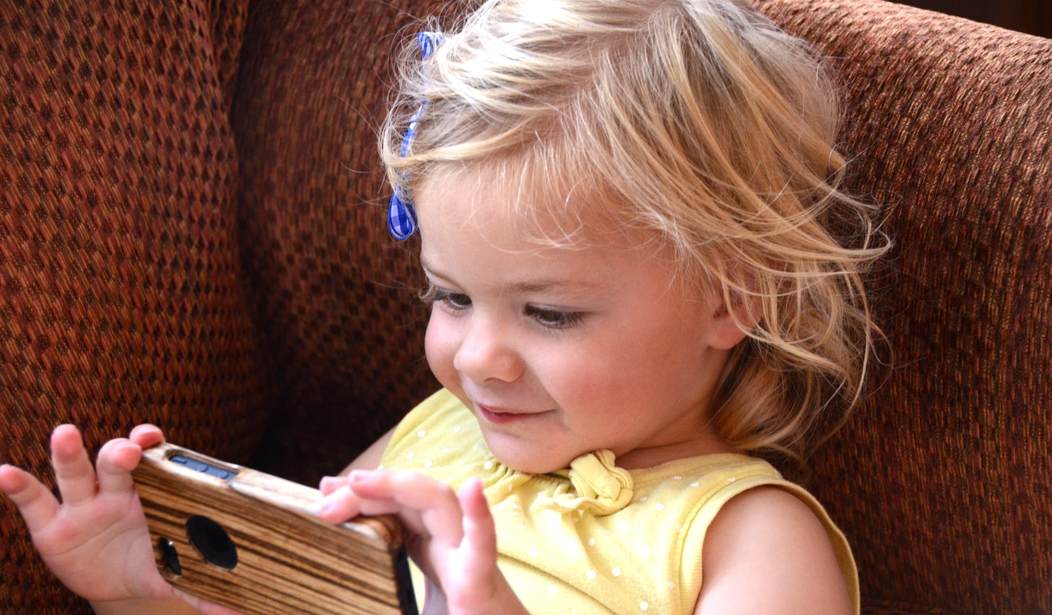It’s possible I was just born in the wrong century or something, but the ubiquitousness of screens (particularly in the lives of children) has me pretty concerned. Don’t get me wrong, a little TV now and then so that Mom can have a much-needed break is, I think, actually a good thing. But the constant use of screens as a way to soothe kids in all kinds of situations seems like a dangerous trend.
Handing a cranky kid an iPhone is the quickest fix in all the world. Suddenly, they’ve not only stopped crying, but they’re completely absorbed in something else, giving you a minute to think. Long wait at the doctor’s office? iPhone! Kid doesn’t want to sit in the grocery cart? iPhone! Waiting for food at a restaurant and you want to talk to other adults? iPhone! It works like a charm. But what message are you really sending? And what behavior are you accidentally enforcing?
See, when kids get handed a screen every time they’re upset or bored, they’re learning some unintended lessons. First, if every time our kids feel a little bored or antsy they get to use the phone, they’re learning that they need the phone in order to be entertained. Or, put another way, they’re not learning important skills for coping with (or just experiencing) boredom.
Boredom is part of life. And, often, being bored forces us to think, reflect, and process in ways we wouldn’t if we were constantly entertained. I’ve had some of my best ideas in moments of boredom. If there’s nothing to do, might as well think!
Secondly, if we use the iPhone as a method of calming distraught children, we’re saying that we aren’t actually available for comfort and support. And we’re not teaching alternate methods of coping with stress, which could lead to real complications later on.
Even when we don’t feel like the things our kids are crying about are a big deal, they’re the biggest of deals to our kids. In moments like these, our kids need us, and they need us to teach them skills for how to cope with adversity. Skills other than turning off their brains by turning on the screen.
Not to mention the fact that, since screen time is always going to be desirable, they’re learning that all they need to do in order to get extra time watching their favorite show is throw a fit. Which is never a good lesson to teach.
Putting away the screens forces you and your child to be fully present, not just for the good moments, but the hard ones too. Which is part of your job as a parent. Kids (people!) need to master resilience if they’re going to be successful in the world. And they need to learn to interact with others, express their needs, and cope with disappointment. It may not be fun, but it’s necessary.
So, what can you do? If you’ve been using your iPhone (or other device) to soothe your child, stopping doing that is going to take a radical shift in your parenting style. Of course, you may not want to stop doing this. You may think what I’m saying is a load of you-know-what and using screens in your parenting is no big deal. And, if that’s true, then that’s totally fine and I don’t know why you’ve read this far. You’re the parent, you make the choices about how to parent your child. But, if you’re conflicted about your child’s screen use, or if you’re actively wanting to change but not sure how, then keep reading.
First, embrace the idea that, for a while, things are going to get much, much harder. Prepare for tears. For tantrums. For whining, and yelling, and general crankiness all around, as you both learn how to deal with adversity without electronic support. And then (as always with parenting strategies that work) set limits.
The best way to do this is to consolidate all the screen time into one block. This will shift the purpose of the screen from comfort-aid to entertainment device. If you’ve been handing over your phone in moments of perceived need, your kid is getting five minutes here, ten minutes there, etc. throughout the day. They don’t see screen time as a fun activity, but as a necessary tool for coping with adversity. So, designate an amount of screen time per day that feels acceptable to you (it’ll be different for each family. We do thirty minutes for my two-year-old) and choose a time of day when it will occur.
Explain to your child that screen time will happen every day at the same time, and that it won’t happen at any other times. Set a timer for the allotted time so that the timer, not you, is “the bad guy” when it’s time to turn it off. And turn it off when the timer goes off, no exceptions. That’s it. (Of course, there are extenuating circumstances, like plane flights, or work meetings. Parents must always be flexible!)
Things will get rough for a while if you do this. But, after that, they’ll get better. Your child will stop whining for the phone, you won’t feel conflicted about when to offer screen time, and your child will learn valuable life skills that will last his whole life long. What could be better than that?









Join the conversation as a VIP Member